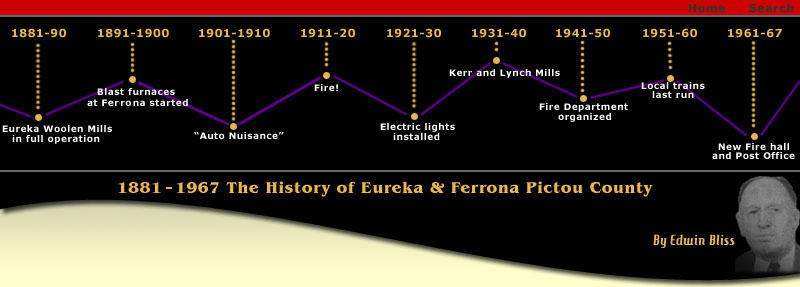1911 - 1920
1911
 In 1911, the Automobile question, still, continued to be a fiery
topic in Pictou County. When the Automobile season again opened in
1911, the regulation restricting their use to Mondays and Fridays
was again in force in the County. The approaching election made it a
particularly delicate and touchy subject to deal with, and the
candidates did not want anything done that would excite and anger
the people. In 1911, the Automobile question, still, continued to be a fiery
topic in Pictou County. When the Automobile season again opened in
1911, the regulation restricting their use to Mondays and Fridays
was again in force in the County. The approaching election made it a
particularly delicate and touchy subject to deal with, and the
candidates did not want anything done that would excite and anger
the people.
Those actively opposed to the Bill, claimed: “Automobiles have come
to stay. If so, why oppose?”
Those actively for the Bill, asked: “Why have they come to stay?
Automobiles have not come to stay. Just wait until they kill a few
people and we will see whether they have come to stay.” Is it
reasonable that the mass of the people who will never own an auto,
will give up the roads they made and practically own to the devil
machines? Is it reasonable to believe that the legislation will take
the roads of the country people away and transfer them to the rich
man, who may wish to make motor tracks of them? Have they come to
the public roads of Great Britain to stay? If so, why is the
Government proposing to construct an automobile road for the
exclusive use of those contraptions, so as to keep them off the
public roads? In England, the public roads are wide and country
comparatively level. There is no chance to escape one of those human
spirits on wheels. In this Province, where the country is hilly and
the roads narrow, if an automobile comes suddenly over a hill in the
face of a horse unacquainted with them, ten men would not keep him
from going over the bank with the wagon to which he may be attached.
Automobiles haven’t come to stay on our country roads and they won’t
stay, March 14, 1911.
Towards the end of 1911, it became apparent that another change was
to be made with the Nova Scotia Woolen Mills, Limited.
1912
The name of the Woolen Mills was again changed, this time to the
Nova Scotia Knitting Company, and as such was capitalized for
$300,000. The water power and equipment were increased. The trade
names of “Eureka” and “Pictou” were retained, having proved a
guarantee of quality and creating a demand that proved hard to cope
with. The Company was placed under efficient management and no time
was lost in getting it in first class shape. More Nova Scotia wool
was to be used in the manufacture of winter, woolen garments, and it
was expected that the more general use of native wool by the Woolen
Mills of Nova Scotia, would result in a revival of profitable
sheep-raising throughout the Province.
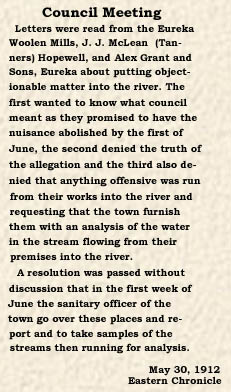 During the month of May, 1912, a protest was lodged by the people
living down the river, concerning the pollution of the East River,
by an outhouse at the Woolen Mills, used by over 100 employees,
situated directly over the mill race. The situation was reviewed by
a Councilor from Stellarton. The result was that steps were taken to
correct the situation and to prevent other refuse of the Mill from
entering the river. During the month of May, 1912, a protest was lodged by the people
living down the river, concerning the pollution of the East River,
by an outhouse at the Woolen Mills, used by over 100 employees,
situated directly over the mill race. The situation was reviewed by
a Councilor from Stellarton. The result was that steps were taken to
correct the situation and to prevent other refuse of the Mill from
entering the river.
During the months of July and August, more controversy arose about
the “Auto Nuisance” in the County. The damage to the streets and
county roads, by the chain bound wheels, was deplored, and also the
noise created by the motor cars. Appearing in the papers were such
articles as: “The Auto Association are greatly surprised that
Country people assert their unalienable right to life, liberty and
the pursuit of happiness. It is next to being a public indecency.
Poor deluded Country People! They presume to retard the joy riding
of the town Plutocrats.”
“The sawmill sounding chuggers were very busy, Sunday, with the
horse and the rubber-tired buggy, we hear nothing but the rhythmical
beat of the horses feet on the roadway; but with the motor car we
have the unmusical sound of the sawmill chugging and that horrid
stink.”
In August, 1912, construction work at the Eastern Car Plant site was
advancing rapidly. Trains were running in and out of the grounds and
two steam shovels were handling the earth and leveling the location.
On a recent Wednesday the local train between Hopewell and Pictou
Landing, carried no less that 1700 passengers during the day’s work.
During the month of August, 1912, Dr. W. H. Robbins and his wife,
who had made a recent trip to Edinburgh, Scotland, returned to the
locality and Dr. Robbins resumed his practice.
In September, 1912, new electric lights were installed in the
Knitting Mill, in Zion Church, and on the streets of Eureka and
Ferrona. Mr. Ballantyne was the current Manager of the Knitting
Mill.
In October, 1912, Dr. W. A. MacLeod purchased the practice of Dr. W.
H. Robbins and located in the village of Hopewell. Dr. and Mrs.
Robbins intended to return to the Old Country, where he would
continue the special studies he had undertaken.
During the month of December, 1912, a young chap of the village,
undertook to beat up Station Agent, Mr. Kenneth McMillan, and did
give him a severe handling. The result was that he was fined $15.
for the offence and bound over to keep the peace for one year.
In December, 1912, Rev. Alexander McLean, D.D., then residing in
Eureka, celebrated his Diamond Jubilee. In 1911, he had published
his book “ The Story of the Kirk in Nova Scotia”. At the celebration
were present: Rev’s Dr. Polly, Mr. Forbes, Dr. Thomas Cumming, Mr.
John Fraser, Mr. Denoon, Rev. A. McLean Sinclair and Rev. Mr.
McNairn.
1913
In March, 1913, a bill was introduced into the local legislature, to
enable the people of Eureka to provide themselves with a system of
Street Lighting. The first Commissioners, under the Act, were George
H. McKay and Donald M. Grant. The amount of the annual expenditure
was not to exceed $325.00
A slight fire occurred at the Woolen Mills, at Eureka, on March 24,
1913, when their picking house was damaged. The loss was not great
and did not interfere with the progress of the works to any
appreciable extent.
The business property of the late William Urquhart & Son, was
purchased in March 1913, by Mr. James H. Reid, who intended to
continue the business as in the past. (The older residents of the
village will remember this grocery business, situated on the brow of
the hill, a few yards closer the bend in the road, than the present
Orange Hall.)
In April, 1913, The Woolen Mills, at Eureka, advertised for “Young
Ladies” for their underwear factory. Offering constant employment,
clean work, good work and good pay, with special wages to those who
were able to run sewing machines.
On April 24, 1913, fire was started under the boilers at the Eastern
Car Plant, at Trenton. The Electric lighting plant was expected to
be in operation in a day or two. (Continued reference is made to the
Eastern Car Plant, because of its importance to the people of Eureka
in later years).
A “Goodfellowship Club” was organized in Hopewell, on June 23, 1913.
Its chief aims were to promote the quest for education and
improvement in the village. It consisted of members from both Eureka
and Hopewell. The second meeting was to be held at the home of Mrs.
A. D. Lynch, Eureka.
The Woolen Plant at Eureka was burglarized in the month of July,
1913, and some goods taken. No cash was secured, it being intimated
that, the burglars probable preferred the famous Eureka Underwear,
which was in such demand and reckoned as good as cash with the trade
then.
A Fireman’s Picnic and Sports Day were held At Eureka, on August 23,
1913, and followed by a dance at Muir’s Hall, in the evening.
The first “Sample Car” to be built at the Eastern Car Plant, was
declared finished on August 30, 1913. This was one of an order of
2,000 cars. The Eastern Car was the first of the assembly firms to
complete their sample car.
On September 22, 1913, a destructive fire raged at Hopewell. It was
believed to have been started by a spark from the locomotive of the
noon express, which set fire to a barn belonging to Alex F. Grant,
meat merchant, from there it spread to other buildings. With no
other fire fighting apparatus, save buckets, the fire made rapid
headway. Three dwelling houses, two stores, a hall and two barns
were destroyed before the fire was brought under control. The smoke
and flames were clearly visible at Eureka, causing much concern
among the older people and excitement amongst the children.
1914
Although the year, 1914, proved to be an historic one in the History
of the World, marking the start of the first World Conflict among
the Nations, there was little of an historic nature taking place in
the village of Eureka and Ferrona. Work was comparatively plentiful
at the Woolen mills, and at the Steel and Car Plants at Trenton, and
the customary social and other routine duties were performed in the
village.
Donald M. Fraser, in 1967, becoming a long time resident of the
village of Eureka, received a badly fractured and lacerated arm, in
April, 1914, in a wood working mill, at New Glasgow, where he was
then living.
Rev. Alexander McLean, D.D., of Eureka, reached his 94th birthday,
on May 20, 1914. He was believed to be the oldest Presbyterian, as
well as the oldest Clergyman of any denomination in Canada.
1915
In March, 1915, following the declaration of War in the previous
year, the Woolen Mills, at Eureka, booked another large order for
their fine underwear for the Military Department. This was their
largest order since the War started.
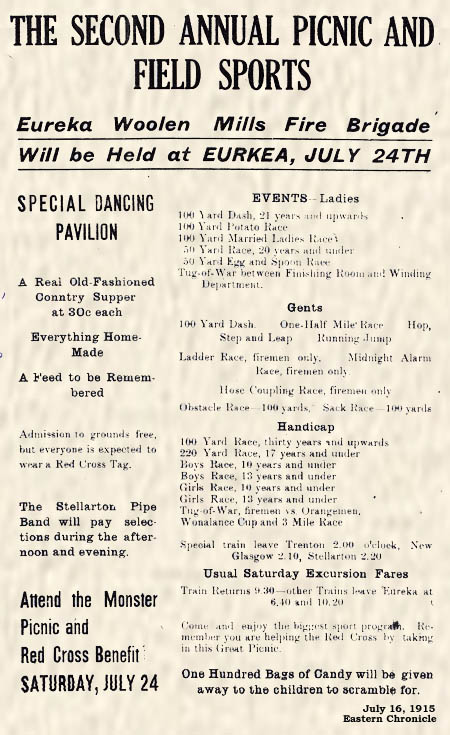 The Woolen Mills, at Eureka, sponsored a Picnic for Red Cross
Benefit, on July 24, 1915. It was a grand success. Receipts were
over $800.00. The Red Cross to profit by about $350.00. After
expenses were paid, $150.00 was to be used to establish a reading
room and library for the firemen and employees at the Woolen Mills. The Woolen Mills, at Eureka, sponsored a Picnic for Red Cross
Benefit, on July 24, 1915. It was a grand success. Receipts were
over $800.00. The Red Cross to profit by about $350.00. After
expenses were paid, $150.00 was to be used to establish a reading
room and library for the firemen and employees at the Woolen Mills.
In September, 1915, another order for 12,000 dozen underwear was
announced by Mr. Ballantyne, for the Woolen Mills, at Eureka. This
order was from the Italian Government and was for its Army Supply
Department. It was one of the largest ever taken by the Nova Scotia
Knitting Company, and was probably the first order placed by the
Italians in Nova Scotia.
The result of the above order was, that tenders were immediately
called by the Nova Scotia Knitting Company, for the erection of an
extension to their plant; a building of wood, two stories high,
having a ground floor area of about 7,000 square feet. Due to War
conditions, the successful contractor would be called upon to rush
the work with all possible speed. The advertisement for tenders was
dated, September 10, 1915.
Towards the end of September, 1915, a complaint was lodged in
regards to the smallness of Eureka Station. From the village,
upwards of 5,000 passengers were traveling by train per month. The
village was progressing as fast, if not faster than any town in the
county.
Disaster struck at the Nova Scotia Knitting Company, and the village
of Eureka, at an early morning hour, on Wednesday, October 13, 1915.
A fire originated in the Carding room, its cause unknown. The flames
got into some oily material and spread rapidly. The whole
countryside was lit up. The conflagration was both spectacular and
awful, striking wonder in some, and terror and consternation in
others. It was a blessing for the village that it was a calm night,
even then, on the following day, charred cinders were picked up,
over a mile distant from the scene. Within a couple of hours the
plant was in ashes. Two carloads of wool were destroyed. A
considerable quantity of goods were removed. The day previous
garments valued at $20,000. were shipped to the Italian Government.
One hundred and fifty men had been employed, working night and day,
on War Orders. Insurance on the plant was reported at $150,000.
W.M.P. Webster, President of the Company, arrived at the scene of
destruction, on the following day, to see what could be done to
restore the Industry.
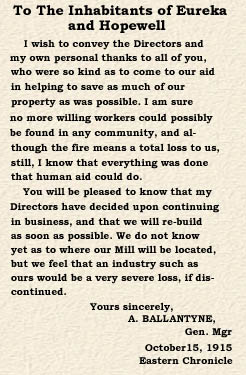 It was quickly decided that the Industry would continue, but, for
the rest of the year, the big question was, where would the new
plant of the Nova Scotia Knitting Company be established? All the
towns in Pictou County, particularly Stellarton and New Glasgow, and
the Town of Windsor in Hants County were considered. Relocation at
Eureka was also considered and hoped for by the people of the
village. Finally at the last of December, 1915, the final decision
came. The Eureka Mills were to go to Windsor. The town of Windsor
offered the following inducements: The purchase of a building, once
occupied by the Textile Company, for $35,000. A bonus of $5,000.
from the town of Windsor. Exemption from taxes and free water for 10
years. It was quickly decided that the Industry would continue, but, for
the rest of the year, the big question was, where would the new
plant of the Nova Scotia Knitting Company be established? All the
towns in Pictou County, particularly Stellarton and New Glasgow, and
the Town of Windsor in Hants County were considered. Relocation at
Eureka was also considered and hoped for by the people of the
village. Finally at the last of December, 1915, the final decision
came. The Eureka Mills were to go to Windsor. The town of Windsor
offered the following inducements: The purchase of a building, once
occupied by the Textile Company, for $35,000. A bonus of $5,000.
from the town of Windsor. Exemption from taxes and free water for 10
years.
After almost thirty-five years of location in the village of Eureka,
having started its establishment, early in the year, 1881, this
Woolen Mill Industry, bowed out from the scene of its birth. An
Industry, that in 1886, after only three years of exhibiting their
goods, was able to display a prize list of a silver and a bronze
medal, a first class diploma from the Dominion Exhibition of 1883,
and eight first class prizes at Provincial and District Exhibitions.
An Industry that was responsible for bringing a Post Office to the
Community and for the Intercolonial Railway building a platform, in
1885, from which the Company could ship their manufactured goods,
and later in 1895, a Railway Station. An Industry, that despite its
many ups and downs, had contributed much to the economy of Eureka,
and provided it with many early conveniences, that were not usually
enjoyed by villages of its size. It left the village it had created,
born of industry and nurtured by the Ferrona Iron Works Boom, to
find a new status in life – that of a purely residential area.
1916
In February, 1916, Miss Jennie McLeod, organist at Zion Church, was
presented with a purse of money and an address.
From the appearance of the following events that occurred in the
year, 1916, it would seem that Industry having departed from the
village of Eureka, “Cupid” moved in and took charge.
Fraser MacGregor MacDonald, of Springville, married Catherine
Florence MacLean, at Eureka, on June 7, 1916.
John Preston MacLean, of Hopewell, married Emma Gertrude Fraser, of
Eureka, on September 12, 1916.
George Francis Kerr, of Eureka, married Margaret Sarah Cumming, of
Fox Brook, in October 1916.
Daniel Elmer Proudfoot, of Hopewell, married Katherine Margaret
Grant, of Eureka, on October 25, 1916.
1917
William Munro, farmer and fine citizen, of Eureka, lost his life by
drowning, while on a fishing trip, on June 23, 1917. With him on the
trip were: William, Kay and Robert McNaughton; Joseph and William
Boates.
In July, 1917, George Wood Sinnis, of Foxbrook Road, was awarded the
D.C.M., for his good work at the front.

In the mid-morning, December 6, 1917, the Halifax Explosion
occurred. It was clearly felt in the Community of Eureka, 100 miles
away; and well remembered, too, was the vicious snowstorm in the
afternoon and evening.
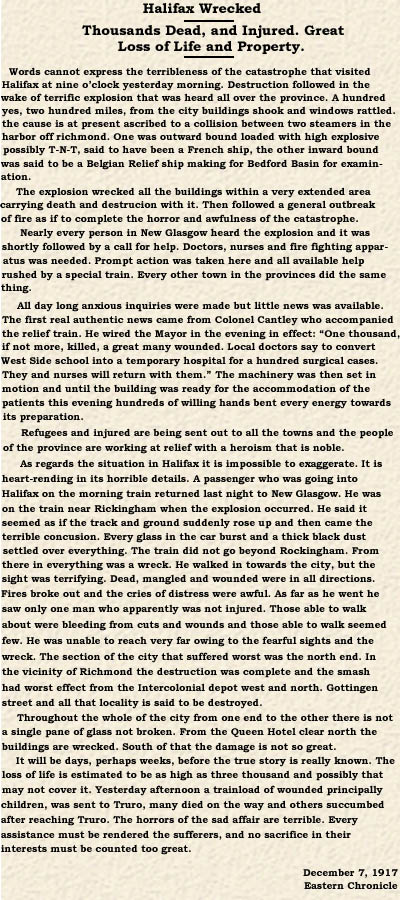
1918
The Eureka school only taught as far as the eighth grade, and it was
customary for those who wished to further their education to go down
to New Glasgow High School to continue their studies. As a rule not
a great many advanced beyond the eighth grade, but in the fall of
1918, a much larger group than usual made the trip for higher
education. There were thirteen students in that group, only one of
them have since died, and none of them are residing, in Eureka, at
the present time.
In November, 1918, the glad news came to the Community of Eureka,
that the Armistice had been signed, on November 11, 1918. No
particular celebration was indulged in, although the display of many
flags about the village was very evident.
1919
The death of Mr. Isaac McNaughton occurred on March 2, 1919,
although his home was actually in Riverton, he had been so closely
connected with the affairs of Eureka for so many years, that he was
considered a resident of the Community. He was a remarkable man,
keen, alert and possessed of boundless energy. An honorable, upright
man with strong convictions for the right. He had made a study of
geology and hankered after the hidden treasures of the earth and
conducted many drilling operations in search of coal, his keen
mechanical instinct being of service to him. He was also a
progressive farmer setting an example to many in the fine acres of
his farm. He was 78 years of age, and only six weeks before, he and
Mrs. McNaughton had celebrated their fiftieth wedding anniversary.
Early in 1919, the firm of Kerr and Lynch was established and a
factory was erected for the manufacture of Yarns, sweaters,
stockingette and other woolen products. The site of this plant was
in the hollow, a short distance above the old mill dam. While
started on a more modest scale than its predecessor, it gave
employment to a number of hands from the village. This industry
continued quite actively for a number of years but began to taper
off in the late 20’s.
In 1919, the village of Eureka and Ferrona was served by four
merchants: D.M. Grant’s store, which was established in 1890, and
which also contained the Post Office; James H. Reid, who took over
the business of William Urquhart. H.H.Reid, son of James H. Reid,
conducted business in the store, formerly run by William Ross; Mrs.
Jemima Gillespie, widow of W.G. Gillespie, kept the fourth store. The
first and last stores mentioned were situated on the Eureka side of
the river, while the two middle ones were on the Ferrona side.
Andrew McLean, farmer, conducted a flour and feed business, which
had been for many years successfully conducted by his brother,
Alex., his supplies were landed at the Eureka Siding. J.W. Gillespie
conducted a livery and trucking business. Hugh McKay, harness maker,
attended to the leather needs of the farmers and other requirements
in the leather manufacturing industry. Everett Muir, son of Sylvanus
K. Muir, supplied the residents of the village with coal from his
coal chute, which was in operation at that time. The undertaking
business was conducted by D. Fraser & Co., of which Stanley
Fraser was the Manager, the coffin-house was located, almost
directly across the road, from the present home of Arthur
Kindervater. In earlier years, a shoe making shop was operated by
Donald Allan Fraser, situated about 50 yards beyond the school. At
the top of the hill, in the Y, where the road from the village
joined the highroad, had been a blacksmith shop that had been
operated by George H. MacKay.
Life went on at a fairly even pace. There were the usual number of
Church Organizations. In the summer, recreation and entertainment
were mostly provided by ball games, swimming in the dam, and
occasional garden parties and picnics. In the winter, there was
skating on the dam and the various ponds, and little persuasion was
necessary to promote a skating excursion over to Churchville lake or
out to Davy’s Lake, on a moonlight night. Coasting on the big hill,
down the road, over the crossing and across the bridge, took place
at all hours, with no interference from cars, as the few that were
in the district, were carefully put away in the winter. House
parties, entertainments and dances in Muir’s Hall occurred quite
often, and frequent trips were made to New Glasgow to see a moving
picture.
In July, 1919, “The Eureka Prospective Power Company” was formed.
This Company proposed to erect 3 major dams along the East River,
with several storage dams to provide against low water. They had
prospects of developing 4,000 H.P., from the 3 dams. The No. 1 dam,
40 feet high, was to be erected at Riverton, on land owned by
Johnson Cameron and William Stewart. It was to have a capacity of
26,000 cu. Fr. Per minute, and develop 1,500 H.P.
No. 2 dam, was to be located on the East Branch of the East River,
near the site of the Old Ferrona Iron Works. It was to have a 100
ft. head, with a supply of 16,000 cu. Ft. per minute, and develop
2,000 H.P.
No. 3 dam, was to be located midway between Eureka and Hopewell, and
was to have a 60 ft. heat, with a supply of 10,000 cu. ft. per
minute, and develop 1,000 H.P. The storage dams to provide against
low water were proposed to be built further up the branches of the
East River.
Because of the enormous price of coal, making power production by
steam was practically an impossibility. The promoters of the Company
believed they could generate electricity for a fraction of the cost
of producing it by steam. The future of the market for power in
Pictou County was foreseen to be very considerable. The promoters
believed that cheap power could be produced. The plant proposed by
the Company would give sufficient power to supply all present market
requirements and return a very satisfactory, dividend, it was
believed, by the Company.
(Apparently the development of this Power Company, like the one
proposed in 1894, did not advance beyond the planning stage.)
1920
In May, 1920, a daring robbery took place at Thorburn, when the
Cashier of the Greenwood Coal Co., Donald A. Campbell, was held up,
shot and robbed of a payroll of $3,100 I mention this occurrence, as
the bandits made their way to Eureka, and going into the store of
James H. Reid, stocked up on supplies, one of them making the
purchases, while the other, watched outside on the door step. Not
long after their departure, police officers arrived and made
numerous inquiries. The bandits didn’t get far, before they were
captured and $2,938. of the payroll was recovered.
On September 22, 1920, Simon McKay Fraser was married to Gladys Ruth
MacNamara.
1921-1930  |
